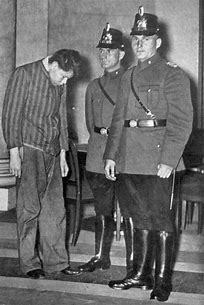On the night of February 27, 1933, just weeks after Adolf Hitler became chancellor of Germany, the Reichstag building in Berlin, then the seat of Germany's parliament, broke out in flames. Police discovered a young Dutchman, Marinus van der Lubbe, inside the building. Van der Lubbe, identified as a communist was charged with the arson and the Nazis immediately laid blame for the fire on the communists. This was followed by a wave of arrests and the rapid banning of other parties. Germany had become a dictatorship.
Van der Lubbe, who appeared to be mentally deficient, presented an apathetic figure at the trial, which took place in Leipzig. He was convicted and subsequently guillotined in Leipzig, where he was interred.
But the mystery of who set actually fire to the Reichstag has lingered to this day. Many have believed that the fire was actually set by the Nazis in order to bring about a crackdown on their political opponents. The question has never been settled.
Today's Dutch newspaper, Volkskrant, has an article on van der Lubbe. His remains were exhumed from a cemetery in Leipzig in late January, and an effort was made to determine through forensic testing if he had been drugged at his trial. It appears the results were inconclusive.
The below article from Volkskrant is translated by Fousesquawk.
Body of Van der Lubbe identified, no evidence that he was drugged
The body exhumed in February in Leipzig is, indeed, that of the arsonist of the German Reichstag building in 1933. But evidence that Marinus van der Lubbe was drugged during his trial not found.
Editorial staff 17 June 2023, 18:56
Caption: Van der Lubbe (standing) at his criminal trial: Image RTBf
The municipality of Leipzig announced that on the basis of the toxicological investigation. The investigation was originally supposed to last a few weeks but is just now publicized. The Dutch Communist, Van der Lubbe, was sentenced to death in Leipzig in 1933 on suspicion of setting the fire in the Reichstag building in Berlin.
Through witnesses at the time and later through historians, it was repeatedly maintained that Van der Lubbe made an apathetic impression in the courtroom where he made a confession. Possibly that was because he was drugged. It is also disputed whether he was the actual arsonist.
From the toxicological investigation, thus, it does not result that he made his confession under the influence (of drugs). Nevertheless, according to the investigators, it cannot be completely ruled out that Van der Lubbe was drugged. According to the report, it is possible that no evidence was found due to the decomposition process, " due to the long period between death and the exhumation."
The investigators have been able to show that the bones in the grave are actually the remains of Van der Lubbe. DNA samples from a tooth were compared with a saliva sample from a grandson of Van der Lubbe's brother. In addition, a historical rumor was debunked. According to some sources, Van der Lubbe was buried at "double the depth" in order to prevent an exhumation, but the exhumation showed that the body was buried at the regular depth of two meters.
Marinus van der Lubbe was born in Leiden in 1909. On February 27, 1933, he was arrested by German police in the burning Reichstag building in Berlin shortly after Adolf Hitler came to power. In December of that year, Van der Lubbe was sentenced to death. On January 10, 1934, he was beheaded at the age of 24.



No comments:
Post a Comment